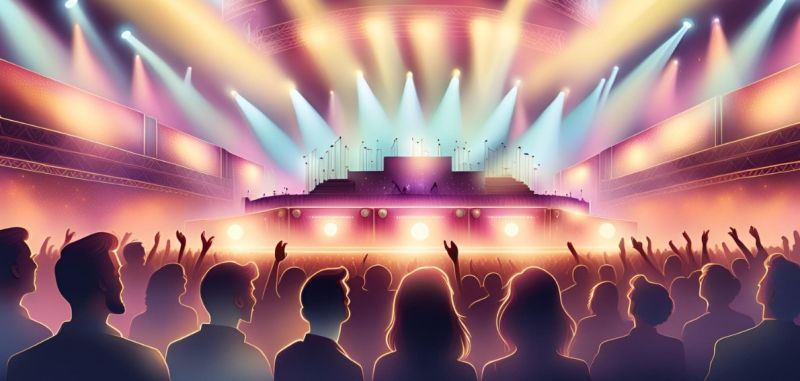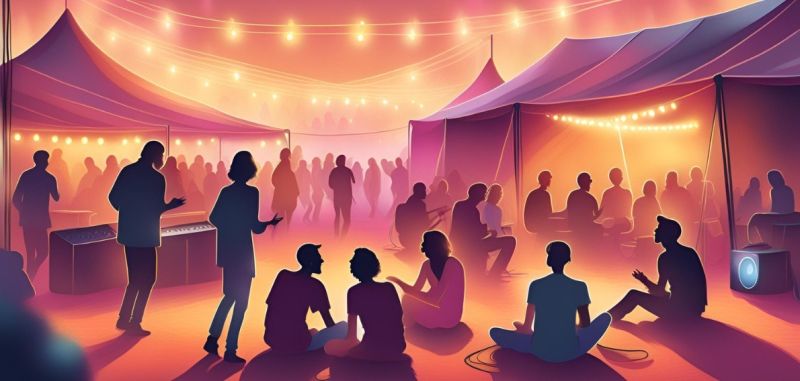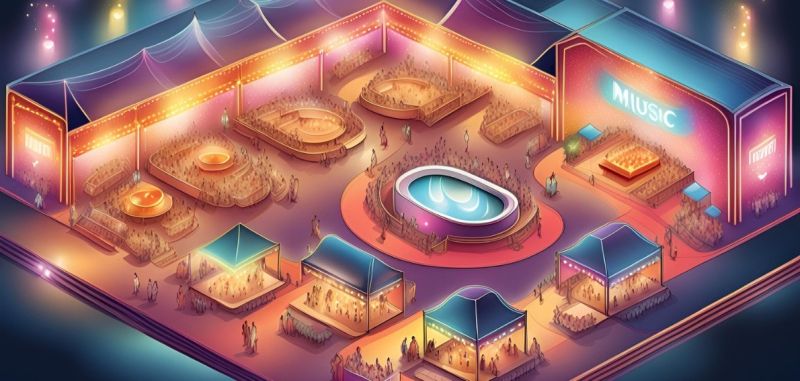Planning a successful music event requires meticulous attention to detail, and perhaps nothing is more crucial than developing a well-thought-out event layout. Keeping event attendees informed and engaged through real-time updates and social media promotions is equally important. Whether you’re organizing an intimate concert venue, a major music festival, or anything in between, your floor plan serves as the blueprint for the entire event’s success. This comprehensive guide will walk you through the essential elements that must be included in your music event floor plan to ensure both safety and enjoyment for all participants.
Planning and Preparation
Define Event Objectives and Activities

Defining clear event objectives and activities is the cornerstone of successful event planning. Your event objectives are the specific goals you aim to achieve, while the activities are the various elements that will engage your attendees. By establishing these early on, you create a cohesive and engaging experience that aligns with your overall vision.
When setting your event objectives, ask yourself:
- What is the primary purpose of the event? Is it to entertain, educate, or promote a cause?
- What key takeaways or outcomes should attendees experience? Are you aiming for increased brand awareness, networking opportunities, or simply a memorable experience?
- How will the event contribute to the broader goals of your organization or brand? Will it drive ticket sales, enhance community engagement, or boost your brand’s reputation?
For event activities, consider:
- What type of entertainment or programming will resonate with your audience? Live music, interactive workshops, or keynote speakers?
- What food and beverage options will be available? Will you feature local food vendors, gourmet catering, or themed refreshments?
- How will you facilitate networking and engagement? Will there be designated networking areas, interactive sessions, or social media integration?
By clearly defining your event objectives and activities, you ensure that every element of your event is purpose-driven and aligned with your goals, creating a seamless and impactful experience for your attendees.
Choose the Right Event Venue or Space

Selecting the perfect event venue or space is a critical decision that can significantly influence the success of your event. The right venue not only accommodates your attendees comfortably but also enhances the overall atmosphere and aligns with your event’s theme and objectives.
When choosing an event venue, consider the following factors:
Capacity: Ensure the venue can comfortably accommodate your expected number of attendees. Overcrowding can lead to a negative experience, while too much empty space can dampen the event’s energy.
Amenities: Check if the venue offers essential amenities such as restrooms, parking, and catering services. Additional features like AV equipment, Wi-Fi, and accessibility options can also enhance the attendee experience.
Theme: The venue should complement the overall theme and objectives of your event. A modern, sleek venue might be perfect for a tech conference, while a rustic outdoor space could be ideal for a music festival.
Location: Choose a venue that is conveniently located for your attendees. Consider factors like proximity to public transportation, parking availability, and nearby accommodations.
By carefully evaluating these factors, you can select a venue that not only meets the logistical needs of your event but also contributes to a memorable and enjoyable experience for your attendees.
Also Read: The Ultimate Guide to Selecting Venues for Touring Artists: A Comprehensive Strategy for Success
The Art and Science of Event Layout, Stage Layout, and Artist Zones

The stage area forms the heart of any music event, serving as the focal point that will capture your audience’s attention throughout the performance. A properly designed stage layout requires careful consideration of multiple factors to create the optimal experience for both performers and attendees. When planning your stage area, consider the venue’s natural acoustics and sight lines to maximize the impact of the performance. An event planner plays a crucial role in creating advance sheets to communicate essential details to artists and managing various aspects of the event.
Your stage should be positioned to provide clear visibility from all angles while ensuring sound can travel effectively throughout the venue. This often means placing the stage at one end of the venue for smaller indoor events, or creating a slight elevation for outdoor venues to help sound travel over the crowd. The stage size should be proportionate to your venue and expected crowd size – too small, and your performers will feel cramped; too large, and you’ll lose the intimate connection between artist and audience.
Also Read: 7 Essential Steps That Go Behind The Perfect Event Stage
Behind the scenes, the artist zones play a crucial role in ensuring smooth event operation. These areas should include well-appointed green rooms where performers can prepare, relax, and focus before their sets. Consider including private bathrooms, mirrors, adequate lighting, and comfortable seating in these spaces. Your green room should be close enough to the stage for convenient access but far enough away to provide a quiet retreat from the main event’s energy.
Loading docks and equipment storage areas need careful planning as well. These should be easily accessible from the exterior of the venue while maintaining a direct path to the stage. This allows for efficient load-in and load-out of equipment while minimizing disruption to the event. Include adequate space for instrument cases, spare equipment, and personal belongings, ensuring everything stays organized and secure throughout the event.
Also Read: The Ultimate Stage Management Guide in 2025: Tools, Trends, and Best Practices
Design a Backstage Area

A well-designed backstage area is essential for events featuring live performances or entertainment. This space should provide a comfortable and functional environment for performers, speakers, and event staff to prepare and relax, ensuring they are at their best when it’s time to take the stage. Your backstage area may also need to accommodate attendees in the event of an artist meet-and-greet.
When designing a backstage area, consider the following:
Space: Ensure there is ample space for performers, speakers, and event staff to move around and prepare. Crowded or cramped conditions can lead to stress and discomfort.
Amenities: Provide essential amenities such as restrooms, dressing rooms, and catering services. Comfortable seating, mirrors, and adequate lighting are also crucial for preparation and relaxation.
Security: The backstage area should be secure and accessible only to authorized personnel. Implement measures such as security checkpoints and access control to maintain a safe environment.
Communication: Establish a clear system for communication between the backstage area and the main event space. This can include walkie-talkies, intercoms, or dedicated staff to relay messages and coordinate activities.
By thoughtfully designing the backstage area, you ensure that performers, speakers, and event staff have a positive and productive experience, which in turn enhances the overall quality of your event.
Also Read: The Backstage Essentials At Every Successful Festival
Maximizing Audience Comfort Through Strategic Event Space Planning

The audience experience largely depends on how well you plan their space within the venue. This goes beyond simply creating open areas for people to stand or setting up chairs – it requires a deep understanding of how crowds move and interact during different types of music events. Effective seating arrangements can maximize space usage, ensuring that your floor plan accounts for various audience preferences and behaviors while maintaining safety and comfort for all attendees.
For seated events, incorporate a variety of seating options to accommodate different preferences and price points. Orchestra seating closest to the stage might feature traditional rows, while areas further back could include elevated platforms or tiered seating to ensure good visibility. Include wider aisles at regular intervals to facilitate easy movement and quick evacuation if necessary. Consider sight lines carefully when planning seated areas – ensure that support poles, sound equipment, or other structural elements don’t obstruct views. Round tables can also be used in seating arrangements to facilitate guest interaction and visibility.
Standing-room events require a different approach to space planning. The importance of space usage in planning standing-room events cannot be overstated. Create natural barriers or levels that help prevent overcrowding in any one area. Consider installing elevated platforms or risers toward the back of the space, allowing shorter attendees to see over the crowd. Implement crowd control measures such as barriers or designated walkways to maintain order and prevent the formation of dangerous crowd densities.
For festivals or larger events, create distinct zones that cater to different audience preferences. Near the stage, design an area for high-energy fans who want to be close to the action. Further back, incorporate more relaxed spaces with some seating options and clear views of video screens. VIP areas should offer premium amenities while maintaining good sight lines and easy access to all services.
Create an Event Map for Outdoor Events

For outdoor events, an event map is an indispensable tool that helps attendees navigate the event space and locate various amenities and activities. A well-designed event map enhances the attendee experience by providing clear and concise information.
When creating an event map, keep the following in mind:
Scale: Ensure the map is to scale and accurately represents the event space. This helps attendees gauge distances and navigate more effectively.
Clarity: The map should be easy to read, with clear labels and symbols. Use color coding and icons to differentiate between various areas and amenities.
Information: Include all necessary information, such as the location of stages, food vendors, restrooms, and emergency services. Highlight key points of interest and any special zones like VIP areas or first aid stations.
Distribution: Plan how the map will be distributed to attendees. Consider providing physical copies at entry points and making a digital version available on your event website or app.
By creating a clear and informative event map, you help attendees navigate the event space with ease, enhancing their overall experience and ensuring they can fully enjoy all the activities and amenities your event has to offer.
Strategic Placement of Food Vendors and Beverage Services

Food and beverage services are not just amenities at music events – they’re essential services that keep your audience energized and hydrated while generating significant revenue. The strategic placement of these services can make the difference between smooth operation and frustrated attendees standing in long lines. Promoting events through social media and targeted advertising can attract attendees to food and beverage services.
When planning food service areas, create multiple nodes throughout the venue rather than concentrating all options in one location. This helps distribute crowds and reduces wait times. Position food vendors along the periphery of main traffic areas, creating natural queuing spaces that don’t interfere with general crowd flow. For outdoor events, consider creating dedicated food courts with shared seating areas, making it easier for groups to enjoy meals together while maintaining cleanliness and order.
Beverage service requires special consideration, particularly when alcohol is being served. Position bars in easily accessible locations but away from high-traffic areas to prevent congestion. Include dedicated ID check stations at entry points to streamline the process of serving alcohol to eligible attendees. Consider implementing a wristband system for age verification to speed up subsequent purchases.
For both food and beverage service areas, ensure adequate lighting and clear signage to help attendees locate services easily. Include trash and recycling stations near these areas to maintain cleanliness, and plan for regular maintenance and cleaning throughout the event. Consider implementing mobile ordering systems for larger events to reduce wait times and improve the overall experience.
Essential Facilities for Event Attendees: Restroom Planning and Maintenance

Proper restroom planning is crucial for event success, yet it’s often overlooked in the initial stages of floor planning. The number and location of restrooms can significantly impact attendee satisfaction and overall event flow. When planning restroom facilities, exceed the minimum requirements based on your expected attendance – it’s better to have too many facilities than too few.
For permanent venues, ensure existing restroom facilities are easily accessible from all areas and clearly marked with visible signage. For outdoor events or venues requiring supplemental facilities, position portable restrooms in multiple locations throughout the space, keeping them away from food service areas but still convenient to access. Include both standard and accessible options to accommodate all attendees.
Consider creating separate restroom areas for VIP sections and staff/performers to manage crowd flow more effectively. Include hand-washing stations and hand sanitizer dispensers near all restroom facilities to promote hygiene. Plan for regular maintenance and cleaning throughout the event, with dedicated staff assigned to monitor and maintain these areas.
Comprehensive Safety and Emergency Planning

Safety considerations should be the foundation of your floor plan, informing every decision from layout to crowd flow. A well-designed safety plan not only helps prevent incidents but also ensures quick and effective response when needed. Your floor plan should incorporate multiple layers of safety features while maintaining the event’s atmosphere and enjoyment.
Start with clear, unobstructed emergency exits positioned strategically throughout the venue. These should be easily accessible from all areas and well-marked with illuminated signage. Create multiple evacuation routes that can handle large crowds quickly and safely. Include emergency lighting systems that automatically activate if primary power fails.
Position first aid stations in easily accessible locations throughout the venue, ensuring medical staff can quickly reach any area where they might be needed. Include dedicated areas for emergency vehicles to access the venue, keeping these routes clear at all times. For larger events, consider including multiple first aid stations and creating a central command center for security and medical staff.
Security personnel placement requires careful consideration in your floor plan. Position security staff at key points throughout the venue, ensuring clear sight lines and easy communication between team members. Include security checkpoints at all entry points, with adequate space for bag checks and crowd management. Create buffer zones between different areas of the venue to help control crowd movement and prevent unauthorized access to restricted areas.
Conclusion
A successful music event floor plan requires careful consideration of numerous elements, all working together to create a safe and enjoyable experience for everyone involved. By taking time to properly plan each aspect – from the stage layout to emergency exits – you create the foundation for a successful event that runs smoothly and safely while maximizing enjoyment for all attendees.
Remember that flexibility is key; your floor plan should be able to adapt to changing circumstances while maintaining its core functionality and safety features. With careful planning and attention to detail, you can create an event space that enhances the musical experience while ensuring the comfort and safety of all participants.
You May Also Like:
OnGround Event Technology For Music Concerts to Know About in 2025
How To Plan a Music Festival 2025: A Comprehensive Guide
Anti Scalping for Event Management: Why These Measures Are Essential – A Complete Guide



 30th June 2025
30th June 2025